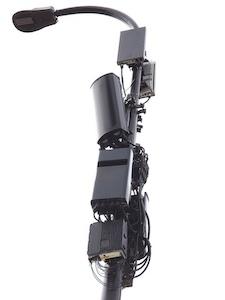2019 marks the year for 5G, which was eventually rolled out for commercial services to consumers. Compared to 4G LTE, 5G is expected to offer significantly higher bandwidth, lower latency, and better scalability (i.e.,supporting more devices). The mainstream 5G deployment employs the millimeter wave (mmWave) technology that can provide, in theory, a throughput of up to 20 Gbps – a 100× improvement compared to today’s 4G. 5G is expected to fuel a wide range of applications that cannot be well supported by 4G, such as ultra-HD (UHD) video streaming, networked VR/AR, low-latency cloud gaming, and vehicle-to-everything (V2X) communication. Despite these potentials, commercial 5G services are at their infancy. In early summer 2019, Verizon launched 5G in Chicago and Minneapolis. It uses a 400 MHz channel at 28 GHz, making it the world’s first commercial mmWave 5G service for consumers. Followed by that, three other major U.S. carriers (T-Mobile, Sprint, and AT&T) have also rolled out their 5G services. Many major carriers around the world are in the process of commercializing 5G.
We conduct to our knowledge a first measurement study of commercial 5G performance on smartphones by closely examining 5Gnetworks of three carriers (two mmWave carriers, one mid-band carrier) in three U.S. cities. We conduct extensive field tests on 5Gperformance in diverse urban environments. We systematically analyze the handoff mechanisms in 5G and their impact on network performance. We explore the feasibility of using location and possibly other environmental information to predict the network performance. We also study the app performance (web browsing and HTTP download) over 5G. Our study consumes more than 15 TB of cellular data. Conducted when 5G just made its debut, it provides a “baseline” for studying how 5G performance evolves, and identifies key research directions on improving 5G users’ experience in a cross-layer manner. We have released the data collected from our study (referred to as 5Gophers) at https://fivegophers.umn.edu/www20.
Publications
- A First Look at Commercial 5G Performance on Smartphones
Arvind Narayanan, Eman Ramadan, Jason Carpenter, Qingxu Liu, Yu Liu, Feng Qian, and Zhi-Li Zhang. The Web Conference 2020 (WWW ’20), 2020
Dataset, presentation talk video/slides available at: https://fivegophers.umn.edu/www20 - 5G Tracker – A Crowdsourced Platform to Enable ResearchUsing Commercial 5G Services
Arvind Narayanan, Eman Ramadan, Jacob Quant, Peiqi Ji, Feng Qian, and Zhi-Li Zhang. SIGCOMM '20 Demos and Posters, 2020 - Lumos5G: Mapping and Predicting Commercial mmWave 5G Throughput
Arvind Narayanan, Eman Ramadan, Rishabh Mehta, Xinyue Hu, Qingxu Liu, Rostand A. K. Fezeu, Udhaya Kumar Dayalan, Saurabh Verma, Peiqi Ji, Tao Li, Feng Qian, Zhi-Li Zhang. ACM Internet Measurement Conference (IMC ’20), 2020
Dataset, presentation talk video/slides available at: https://lumos5g.umn.edu
